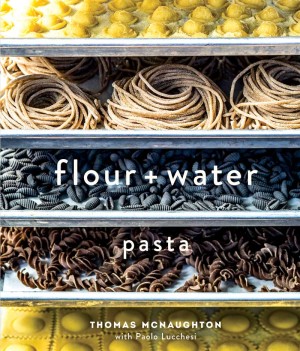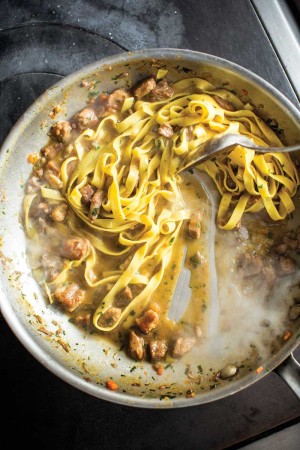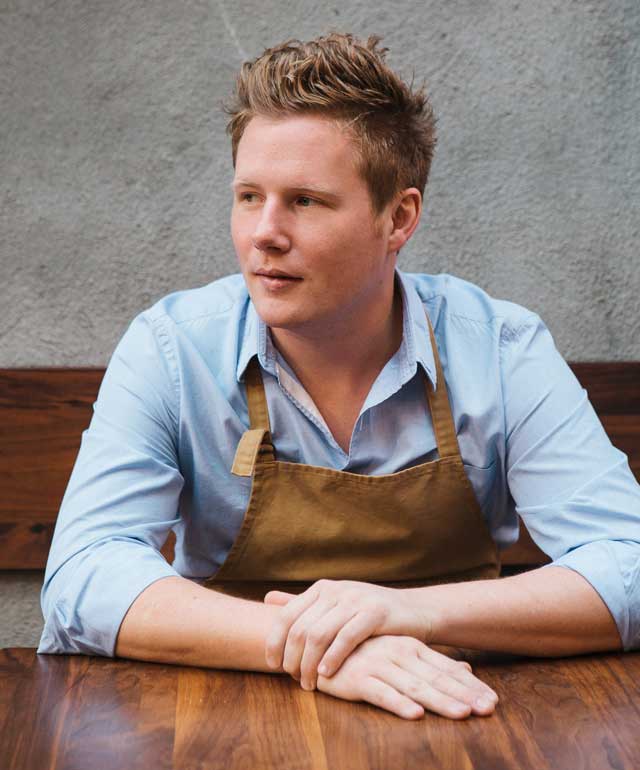Meet Thomas McNaughton, chef at flour + water, central kitchen and salumeria in San Francisco and author of the new book Flour + Water: Pasta. After working in some of the city’s best kitchens, he continued his culinary education in Europe and ended up in Bologna, where he learned to make fresh pasta by hand. Together with business partners David White and David Steele, he opened flour + water to add his own California twist to the traditional pasta specialties he mastered in Italy.
Here, Thomas tells us what he loves about pasta — and how he devoted a whole room in the restaurant to making it! — and why his future plans include starting a goat farm. Read on!
Where did you grow up? Was cooking a part of your childhood?
I grew up in south Jersey, and cooking was definitely not a part of my childhood. We had pizzas and cheesesteaks. I started working in kitchens when I was young, at 14, and everything evolved from there.
How did you start a cooking career?
I started washing dishes as a summer job, but I wasn’t really interested. Then, in my mid to late teens, I started to take it really seriously. I liked the craftsmanship, the creative nature – thinking about dishes and how they came together. Also, the dynamic atmosphere of the kitchen and the high-energy teamwork. I started to buy cooking equipment and would cook for my girlfriend and my mom. By the time I was 16 or 17 I knew I wanted to take it seriously as a career.
 You started out working in fine dining restaurants in San Francisco. Why did you move away from that? What were you looking for that wasn’t there?
You started out working in fine dining restaurants in San Francisco. Why did you move away from that? What were you looking for that wasn’t there?
I didn’t so much want to move away from it. At Flour + Water the food is still much more refined than most rustic Italian restaurants. I’m still doing the same kind of food as other places. But I’ve worked at fine dining restaurants where most of the cooks had never even eaten at the restaurant at all. In the back of the kitchen, you’re not making much money so often they couldn’t afford it, but it also had so much to do with the atmosphere. They were intimidated. I found that really sad.
San Francisco is such a casual town. I really wanted to create a fun, lively atmosphere but still put refined food on the plate. It’s kind of a new juxtaposition – now, five years later, we see it even more. I remember we got a really good review right off the bat at Flour + Water, and this older lady came into eat and I was expediting service and she said, “This is the worst fine dining restaurant I’ve ever been to in my life.” It confused people at the beginning.
Tell us about going to Italy and falling in love with pasta in Bologna.
I traveled to Europe to learn and to stage in kitchens, from Michelin three-star restaurants to a pasta lab in Bologna. It’s something that’s very much based on tradition. I was more intimidated working in a shop with 12 old ladies who’d been doing the same thing for 40 years of their lives than I was beside three-star Michelin chefs. How it’s steeped in tradition – it fascinated me. I was working in Bologna, seeing these very old techniques and how much reverence they have for them.
Definitely for Americans, there’s a mystery that is behind pasta. The best meals I’ve had in Italy were all in someone’s home, not in a restaurant. Going home and cooking for hours is part of their daily experience; it’s not slaving away, it’s a family event. It’s part of their culture. Part of American culture is making cooking faster and easier. So that was an awe inspiring moment for me, seeing this style of food. Pasta takes time and room to produce.
What do you love about pasta from a food perspective?
Pasta has so much to do with texture and how that’s interwoven with flavor, and how they really affect each other. It’s fascinating to me what goes into making an epic pasta; it has so much to do with how it’s produced. If it’s on a wooden surface versus marble or metal, to the ingredients we’re putting into it – so much has to do with basic ingredients. It’s the simplistic nature of it.
Tell us the story of how you applied for the flour + water job on Craigslist. What was going through your head?
I was traveling for a while and ended up in Bologna, but my girlfriend was still in San Francisco, so I was trying to make my way back there. I was running low on funds and was in contact with friends, trying to find out what was going on in the San Francisco food scene and where I wanted to ended up. When I saw the posting on Craigslist I responded in three sentences, saying, I have no resume, I worked at Gary Danko, La Folie and Quince, and I’m moving back to San Francisco to be a goat farmer. My now business partner responded back: Tom, is that you? I didn’t know I was emailing him. He was like, what the hell are you talking about?
Any plans to start a goat farm?
One day, definitely. We actually just retrofitted one of our buildings that houses Central Kitchen and Salumeria – it has a 4,000-square foot roof. We’re still in the planning process but we’re adding a garden and greenhouses. We had a beautiful 600-square foot garden on a different roof, with 12 chickens, beehives and edibles, but we didn’t get permits for it so the landlord evicted us. Now, we’re coming back with a 4,000-square foot one.
Being a chef in the Bay Area, that has to do with the job description: searching out the best possible food, from whole animals to where our tarragon comes from. That’s not necessarily a focus all over the world. It’s something that’s really important to me; if we make vinegar, we understand how to better use that vinegar in a dish. It’s the same thing with animals and plants.
We have an overarching plan for an off-site farm. Here, we’re going to have three greenhouses. It’s questionable if the chickens will make it back up there; legally, it was questionable. We were raising them to see how different breeds affect the eggs we use for pasta. But it will be all different kinds of edibles, and we’re growing things from seed. We’ll probably have eight citrus trees, larger fruit-bearing trees, small lettuces. It’s more to educate our cooks and to have them be a part of that experience.
You weren’t a fan of the name flour + water in the beginning. What do you think about it now?
Eh. Most people don’t forget it.
Your partners’ vision for the restaurant changed when you came on board. How did the project evolve?
When I was in Bologna, I was spending hours in phone booths talking to them, developing plans. Their thought was an extremely rustic food program. Appetizers were marinated beets served in a bowl – they wanted a neighborhood restaurant with simple food.
Quite frankly, it scared me a little bit; it was so typical of what was going on in the Bay Area. Rustic Italian is the breadwinner in San Francisco. As a young, dumb chef, I wanted to say, this is something I can do – I can pull this off. But it was kind of a juxtaposition at the very beginning. I think they were nervous of my ideas. David White would be in the restaurant while we were testing, saying, that dish is getting a little too fancy. But I think we have an amazing partnership because we all assume ultimate control of what’s in our domain. There’s a healthy tension of asking questions, like, what’s the purpose of this? It makes a great partnership. They put a massive amount of faith in me.
You opened with a line out the door. What was your reaction to all the attention?
I was pissed at David Steele because he told every friend and media person he knew that we were opening that night. It was terrifying. I was dry heaving in the bathroom.
The hours were going to be 5:30 to midnight, but we were going to soft open. We ended up opening the doors at 6:30. It wasn’t because we were ready, but a massive crowd had formed outside. I couldn’t even tell you about the first night’s service. It was crazy to be a part of it. There were so many learning curves, but I’m a firm believer that you have to dive in headfirst.
There has never been a dip in covers here. The first week is fine because there’s all this adrenaline, but two to three months in — that’s the tough time. I lived two blocks away, but I was sleeping at the restaurant.
Has it settled down?
We’ve matured as a company, and that’s what makes it seem like it’s settled down. We started with 30 employees, and now I have between 135 and 140 company wide. It’s still crazy, it’s just a lot less crazy.
Right before our positive review came in, around the third month in, my partners bought me a hotel room up in Healdsburg with a spa package and kicked me out of the restaurant. I hadn’t taken a day off for the first 90 days. There was just too much to do.
No prep cooks, whole animal butchery, in-house charcuterie – did you find there was a disconnect between your ideals as a chef and the logistics of a small restaurant?
We really upheld all of our core values. Buying a whole animal means knowing where it comes from and what it’s fed. Buying from small, local farms – the biggest thing for us is that the farms dictate what goes on the menu. We don’t say, we want to do this dish with salmon. We talk to the middleman and he says, I have beautiful, local salmon. We get the salmon first. We talk to farmers and get the best of the best, order it, look at it and say, what do we want to do with it? The menu starts with raw ingredients, not an idea. We certainly upheld that. It’s how all the restaurants run.
When we first opened I was 24 years old – a young, dumb line cook. My idea was there were not going to be prep cooks because I didn’t want a disconnect between how we were serving and what we were doing. We didn’t have a single prep cook in the morning, so my first cooks were working 16-hour days, and I was working 18 or 19 hours. I certainly lost a pound or two. It was just unrealistic for as busy a restaurant as we are. We’re serving 200 people every night – that’s a lot of food to feed people. We weren’t properly equipped to serve 200 people. We had a $500 stove that would break down and a tiny kitchen downstairs, where we could barely plate the food to serve.
It was out of necessity that we expanded our pasta program. We expanded in the back of the restaurant to build a dough room, so our focus turned to that.
Did you model it after what you saw in Bologna?
Absolutely. At the center is a massive butcher block, and that’s how the dough rooms in Bologna were set up. Everyone can work around the same table, so we can have six people making pasta at the same time.
 You’re known for your pasta – what’s special about it? Why do you think people have responded so strongly?
You’re known for your pasta – what’s special about it? Why do you think people have responded so strongly?
I think it’s just developing that dough room – we really created a pasta program. Very few restaurants have an evolved pasta program. There are pastas on menus everywhere, but not a really evolved pasta program, that research and development of how we produce our doughs, where we met Harold McGee and talked about science: what does an egg yolk do versus an egg white, that sort of thing. We were developing so many different doughs and systems to how we produced pasta.
Tell us about working with Harold McGee.
We have a test kitchen above flour + water with a library, so cooks can check out books. It’s a pretty large culinary library. Harold McGee’s book On Food and Cooking was written in ’84, a year after I was born. Still, to this day, it’s the most stolen book in the library. I found out he lived in the Bay Area, and at the time I was saying things about how we do things with doughs. I was like, I need to have all these things validated! So I bought him lunch and we picked his brain for a couple of hours. I was about 95% right in what I was saying.
The main thing is, we cook pastas 80% in starchy water and 20% in sauce. We’re always finishing them in sauce. I thought, two things happen: the pasta starches weep out a little and stabilize the sauce, and the pasta is absorbing the flavors of the sauce. After really getting into it, that’s not really true. All that noodle is capable of absorbing is water. If you have a sauce, most of the flavors are packed in the oils in the sauce, but water is pure water. So pasta is absorbing water but adsorbing flavors – the flavors aren’t penetrating the pasta but creating a skin on the outside of the noodle. We learned little things like that.
What’s your current process for pasta production?
The lab opens at seven in the morning. The first two hours is just making doughs by hand; we hand-knead all the doughs. Everyone has this romanticized idea of working in the dough room, but it’s a hard job. You’re hand-kneading doughs for a couple of hours, then going into production. Out of that room we produce all of our retail pasta for Salumeria and for Central Kitchen as well.
You live above the restaurant. Is that a coincidence?
The apartments above the restaurant weren’t finished when the restaurant was opened. It was about eight months in. My friend and I both broke up with our live-in girlfriends at the time and we moved into the apartment upstairs when it wasn’t ready. We went about three months without running water. We got memberships to the rock climbing gym down the street, where we showered.
All of the restaurants are just down the street, so it’s amazing to have been so close for the past five years. But I’m ready to move out now.
Tell us about opening salumeria and central kitchen after flour + water. How did the new projects come about?
It really started with salumeria. We started talking about it week one of flour + water – having a retail shop to sell our house-cured meats, olive oils and the salts we used. The physical space we just found on the street, with the same landlord; it was an old sausage factory. It was a really beautiful space, and that dictated what we wanted to do there.
The openings of salumeria and central kitchen were 10 times harder than flour + water. It was going from 30 employees and being able to manage it every day to having 130 employees – insane. It was tough opening, but today it’s amazing. I’m incredibly proud of them. It was new to me to be responsible for three massive kitchens.
What about the Flour + Water: Pasta book? What made you want to write it?
David Steele came to me and said, I think you should write a cookbook. I was like, get the hell out of here. Like I need one more thing!
It wasn’t just taking the recipes from our kitchen and converting them to home recipes. It was extremely difficult. With the restaurant, it’s a constant evolution, but a cookbook is permanent. You can’t change it a year in. So he said, why don’t we just focus on pasta? That made more sense to me. There wasn’t really a great pasta book out there that people could actually cook from and had a sense of being of the times, right now.
It all happens very quickly. Two years ago we started working on it. We built the test kitchen above the restaurant to work on the cookbook – that’s where we did the food photos, because it has beautiful light. Both Eric [Wolfinger, the book’s photographer] and Paolo [Lucchesi, co-author] were already friends. When we first started writing it, we thought, OK, it’s going to be a pasta book, but we didn’t think about how it was going to be organized. It evolved over the course of two years.
Ten Speed [Press, the publisher] was amazing. They were like, just do your thing. There was a huge amount of faith and trust from them for us to create something worthwhile.
Try recipes from Thomas McNaughton here.


2 comments
[…] Q&A with Chef Thomas McNaughton […]
[…] Q&A with Chef Thomas McNaughton […]